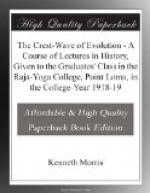XXV. TOWARDS THE ISLANDS OF THE SUNSET
I had not thought to speak to you further about Celtic things. But there is something in them here which concerns the spiritual history of the race; something to note, that may help us to understand the Great Plan. So, having beckoned you last week to the edge of the world and the fountain of dawn, and to see Bodhidharma standing there and evoking out of the deep a new order of ages, I find myself now lured by a westward trail, and must jump the width of two continents with you, and follow this track whither it leads: into the heart and flame of mysterious sunset. I hope, and the Gwerddonau Llion, the Green Spots of the Flood,—Makarn Nesoi, Tirnanogue, the Islands of the Blest.
We saw that while the great flow of the cycles from dying Rome ran in wave after wave eastward, there was a little backwash also, by reason of which almost the last glow we saw in the west was in fourth century Gaul, in the literary renaissance there which centers round the name of Ausonius. Now in later history we find every important French cycle tending to be followed by one in England: as Chaucer followed Jean de Meung; Shakespeare, Ronsard and the Pleyade; Dryden and Pope, Moliere and Racine; Wordsworth and Shelley, the Revolution. And we have seen China wake in 420; and we have noted, in the first of these lectures, the strange fact that whenever China ‘gets busy,’ we see a sort of reflexion of it among the Celts of the west. And we shall come presently to one of the most curious episodes in history,— the Irish Renaissance in the sixth century: when all Europe else was dead and buried under night and confusion, and Ireland only, standing like a white pillar to the west, a blazing beacon of culture and creative genius. Now if you see a wave rising in fourth-century Gaul, and a wave breaking into glorious foam in sixth- and seventh-century Ireland,—what would you suspect?— Why, naturally, that it was the same wave, and had flowed through the country that lies between: common sense would tell you to expect something of a Great Age in fifth- and early sixth-century Britain. And then comes tradition,—which is nine times out of ten the truest vehicle of history,—and shouts that your expectations are correct. For within this time came Arthur.
You know that in the twelfth century Geoffrey of Monmouth published what he claimed to be a History of the Kings of Britain from the time of the coming there of the Trojans; and that it was he mainly who was responsible for floating the Arthurian Legend on to the wide waters of European literature. What percentage of history there may be in his book; how much of it he did not “make out of whole cloth,” but founded on genuine Welsh or Breton traditions, is at present unknowable;—the presumption being that it is not much. But here is a curious fact that I only came on this week. The Romans were expelled from Britain in 410, remember. Arthur passed from the world of mortals on the night after Camlan, that




